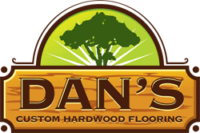Types of Wood Flooring: Your 4 Options
When starting out with your Boston wood floor installation project, the first big decision you’ll need to make is choosing between one of the 4 main types of wood flooring. There’s real wood flooring and ‘wood look’ or faux wood flooring.
The four main types of wood flooring are: The first two are real wood floors. The last two are faux wood flooring, they kind of look like wood but they aren’t. They each have their unique characteristics, advantages, and disadvantages.
The first two are real wood floors. The last two are faux wood flooring, they kind of look like wood but they aren’t. They each have their unique characteristics, advantages, and disadvantages.
Let’s have a closer look at each of them...
One of the biggest benefits of this type of wood flooring is it can be sanded and refinished multiple times over its lifetime. Giving the potential for brand new looking floors time and time again.
With solid wood flooring, you have the ability to create a totally custom floor, like the hardwood floors south of Boston we installed below...
 Solid wood flooring can be installed in most areas of the home, including wood floors in kitchens. But they can't be installed below grade, and you need to be careful of the ¾ inch height if installing over existing flooring in kitchens to make sure appliances and doors still fit.
Solid wood flooring can be installed in most areas of the home, including wood floors in kitchens. But they can't be installed below grade, and you need to be careful of the ¾ inch height if installing over existing flooring in kitchens to make sure appliances and doors still fit.
Like solid wood flooring, engineered floors with a thick wear layer can be sanded and refinished multiple times, allowing these types of wood flooring to look brand new again.
 Wear layers can range from thin veneers in cheaper options, to solid wood layers that match the thickness of solid hardwood planks in high-end choices. Both prefinished and unfinished engineered wood floor options are available.
Wear layers can range from thin veneers in cheaper options, to solid wood layers that match the thickness of solid hardwood planks in high-end choices. Both prefinished and unfinished engineered wood floor options are available.

 *Out of these four types of wood flooring, we only supply, install and sand and refinish solid wood and high-quality engineered flooring for our customers in around Braintree, Hingham, Cohasset, Duxbury, Boston and the greater South Shore Massachusetts area. The faux options are discussed here to show a comparison. They definitely have their place in the flooring industry, we just don’t work with them.
*Out of these four types of wood flooring, we only supply, install and sand and refinish solid wood and high-quality engineered flooring for our customers in around Braintree, Hingham, Cohasset, Duxbury, Boston and the greater South Shore Massachusetts area. The faux options are discussed here to show a comparison. They definitely have their place in the flooring industry, we just don’t work with them.
The four main types of wood flooring are:
- solid wood
- engineered wood
- laminate
- luxury vinyl plank (LVP) or luxury vinyl tile (LVT)
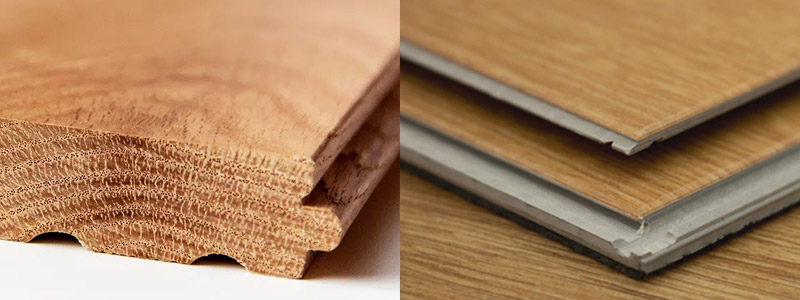 The first two are real wood floors. The last two are faux wood flooring, they kind of look like wood but they aren’t. They each have their unique characteristics, advantages, and disadvantages.
The first two are real wood floors. The last two are faux wood flooring, they kind of look like wood but they aren’t. They each have their unique characteristics, advantages, and disadvantages.
Let’s have a closer look at each of them...
Solid Wood Flooring
This flooring is crafted from solid planks of real wood, usually in¾ inch thickness. It’s 100% real solid wood all the way through. It comes in various width boards and planks and is available in unfinished as well as prefinished variations. There are centuries old solid hardwood floors still in use here in the Boston area. One example is the Paul Revere House that was built in 1680 with it's 300+ year old solid wood flooring still going strong.One of the biggest benefits of this type of wood flooring is it can be sanded and refinished multiple times over its lifetime. Giving the potential for brand new looking floors time and time again.
With solid wood flooring, you have the ability to create a totally custom floor, like the hardwood floors south of Boston we installed below...
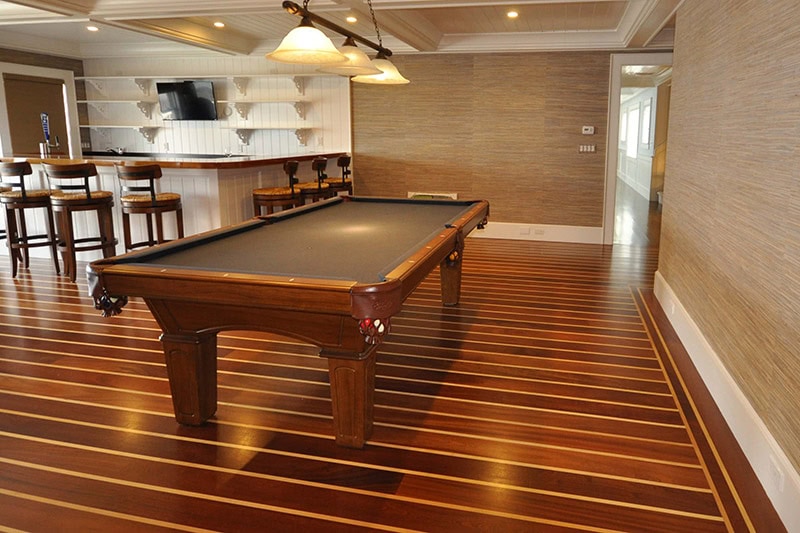 Solid wood flooring can be installed in most areas of the home, including wood floors in kitchens. But they can't be installed below grade, and you need to be careful of the ¾ inch height if installing over existing flooring in kitchens to make sure appliances and doors still fit.
Solid wood flooring can be installed in most areas of the home, including wood floors in kitchens. But they can't be installed below grade, and you need to be careful of the ¾ inch height if installing over existing flooring in kitchens to make sure appliances and doors still fit.
Pros:
- Exceptional durability and lifespan. Solid wood floors can last for centuries.
- It can be sanded and refinished multiple times, looking brand new each time
- Authentic, natural beauty and character, every plank is unique
- Unfinished options are fully customizable to suit your style with stains, finishes and intricate layouts/patterns
- Potential to increase home resale value
Cons:
- Higher cost compared to other options, especially the faux lookalike floors
- They’re susceptible to moisture and humidity changes, leading to possible shrinking, expanding, cupping or warping issues
- A longer and more complex installation process than some of the other options
- 3/4-inch height may cause issues with doorways and kitchen appliances
Engineered Wood Flooring
Engineered wood flooring is a great alternative to solid wood. Instead of being a single solid ¾ inch thick plank, engineered floors have multiple base layers of plywood laid in opposing directions. The quality and number of the ply layers impacts the overall stability. The more the better. This allows for a durable, dimensionally stable floor at a lower cost than solid hardwood flooring. Some are thinner than ¾ inch, which helps where there are height issues.Like solid wood flooring, engineered floors with a thick wear layer can be sanded and refinished multiple times, allowing these types of wood flooring to look brand new again.
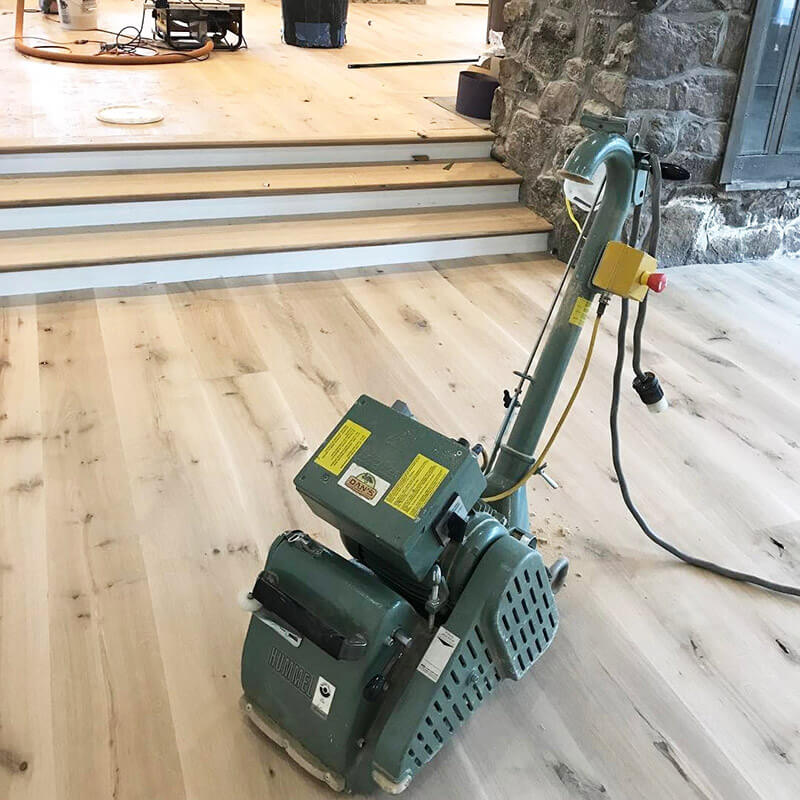 Wear layers can range from thin veneers in cheaper options, to solid wood layers that match the thickness of solid hardwood planks in high-end choices. Both prefinished and unfinished engineered wood floor options are available.
Wear layers can range from thin veneers in cheaper options, to solid wood layers that match the thickness of solid hardwood planks in high-end choices. Both prefinished and unfinished engineered wood floor options are available.
Pros:
- Increased stability over solid wood flooring
- Suitable for installation below grade or over concrete
- Often more affordable than solid wood flooring
- More sustainable than solid wood, the same hardwood tree can make 3x the flooring
- High-end options have the same wear layer as solid wood, meaning they can be sanded and refinished multiple times
Cons:
- Low-end variations have limited refinishing options due to the thin wear layer
- Cheaper options with thin veneer top layers won’t have the same authentic feel as solid wood
- Still can be susceptible to excessive moisture or humidity
- Cheaper prefinished options have bevels on the edges which not everyone likes
Laminate Flooring*
Laminate flooring is the budget-friendly option. It’s made with high-pressure laminate over a high-density fibreboard (HDF) core. It’s designed to mimic the look of natural wood. It's durable, resistant to scratches and stains, and easy to install as most come as a click lock system. Can be installed as a floating floor.Pros:
- A very affordable option versus the real wood flooring choices
- Thinner than solid wood flooring for installations with height issues
- Laminate is durable and resistant to scratches and stains
- It’s easy and fast to install, especially click in floating installations
- Can be installed below grade and over concrete with proper preparations
Cons:
- Laminate can’t be sanded or refinished
- It has an artificial faux appearance
- Susceptible to moisture damage if not properly sealed
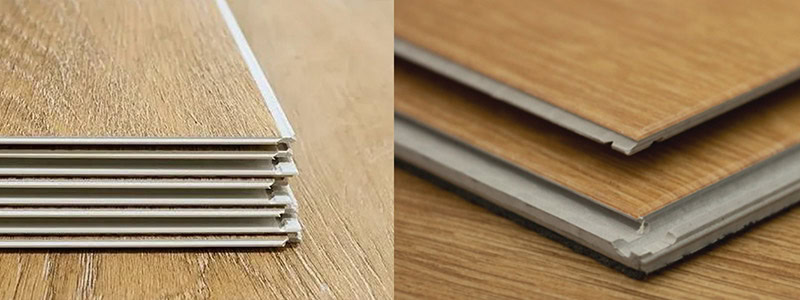
Luxury Vinyl Tile (LVT) and Luxury Vinyl Plank (LVP) Flooring*
LVT and LVP flooring combines the all the benefits of laminate and vinyl flooring. It offers durability, moisture resistance, and easy installation. It's a great option for below-grade and wet areas, something not all of these types of wood flooring can do. Pros:- Highly durable and resistant to scratches and stains
- Resistant to moisture and humidity
- Suitable for installation below grade or over concrete
- LVT is relatively easy to install
- It’s faux, plastic look makes it easy to tell it’s not real wood
- Repetitive and uniform board sizes make it look artificial compared to random length solid wood flooring
- Cannot be sanded and refinished
Factors to Consider Before Choosing Between these 4 Types of Wood Flooring
- Installation and Subfloor Requirements: Engineered wood flooring, laminate, and LVT flooring can be installed below grade unlike solid wood flooring. They are thinner than solid wood flooring too if that’s important. Click lock flooring is fast, but unfinished solid wood floors have far more opportunity for customization in the installation process.
- Budget and Cost: If budget is a big concern for your South Shore Massachusetts hardwood floor installation, then laminate and LVT flooring are far more affordable options. However solid wood and engineered wood flooring can last for decades, if not centuries, because they can be sanded and refinished multiple times. This makes them way more affordable (and environmentally friendly) types of wood flooring over the long run.
- Maintenance and Repair: Solid wood and engineered wood flooring can be spot repaired when you have issues like pet stain damage and can have maintenance coats applied when scratched or damaged. Laminate and LVT flooring require individual board replacement when they get damaged, and you’ll need to keep spares in case you can’t buy the same boards down the road. All are easy to clean, but bevel edges on cheaper options in all four types of wood flooring can be more work.
- Appearance: If you want genuine 100% hardwood with all the character, natural look, sound and feel it offers, then solid wood and high-quality engineered wood flooring are the best options by far.
- Long-term Value to Your Home: Solid wood and engineered wood flooring increase the value of your home, making them a great investment for homeowners who plan to sell in the future. Laminate and LVT flooring don’t have the same long-term value.
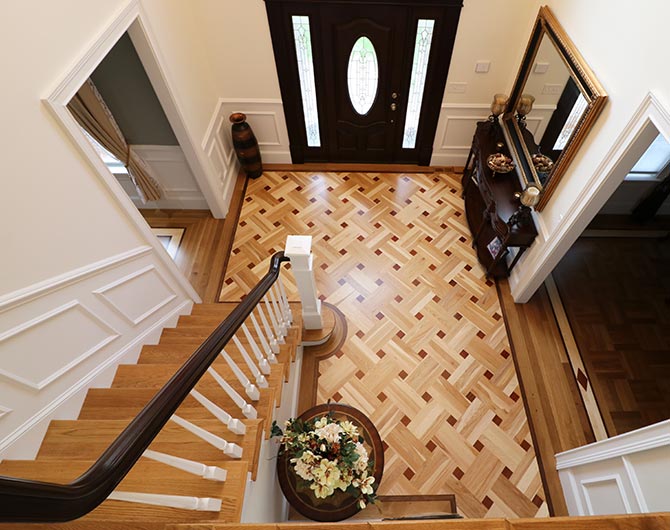 *Out of these four types of wood flooring, we only supply, install and sand and refinish solid wood and high-quality engineered flooring for our customers in around Braintree, Hingham, Cohasset, Duxbury, Boston and the greater South Shore Massachusetts area. The faux options are discussed here to show a comparison. They definitely have their place in the flooring industry, we just don’t work with them.
*Out of these four types of wood flooring, we only supply, install and sand and refinish solid wood and high-quality engineered flooring for our customers in around Braintree, Hingham, Cohasset, Duxbury, Boston and the greater South Shore Massachusetts area. The faux options are discussed here to show a comparison. They definitely have their place in the flooring industry, we just don’t work with them. 